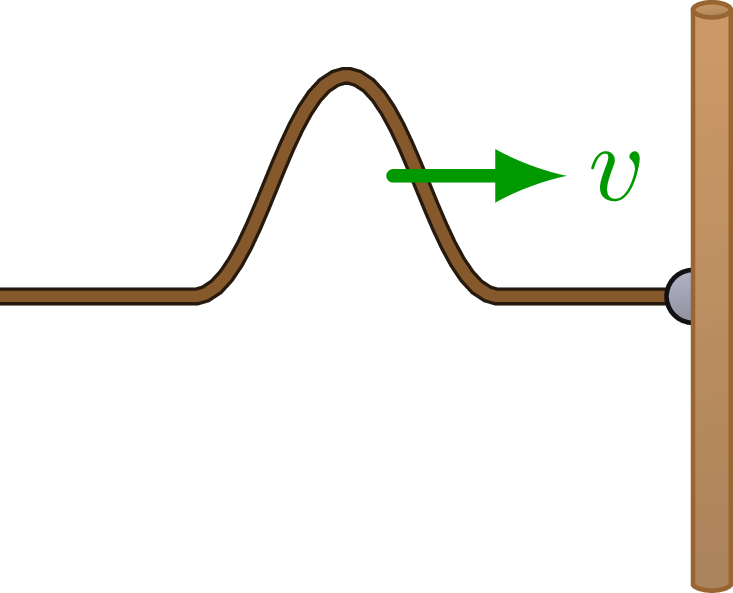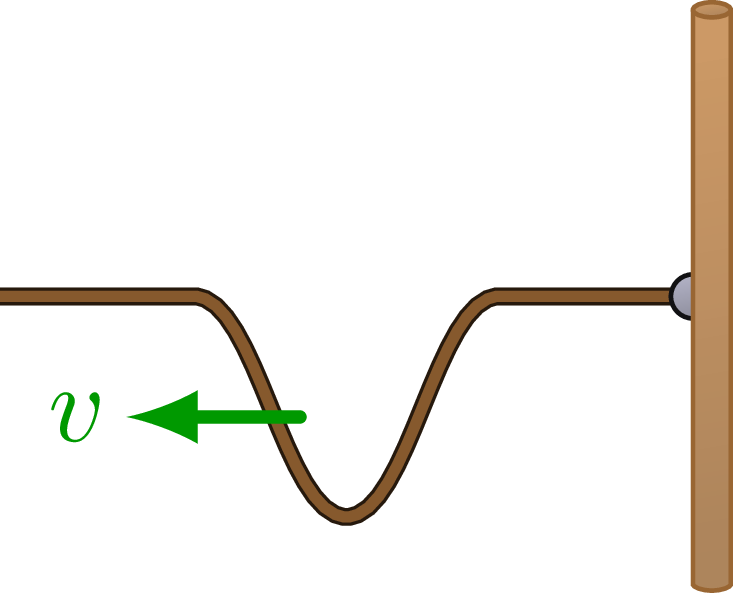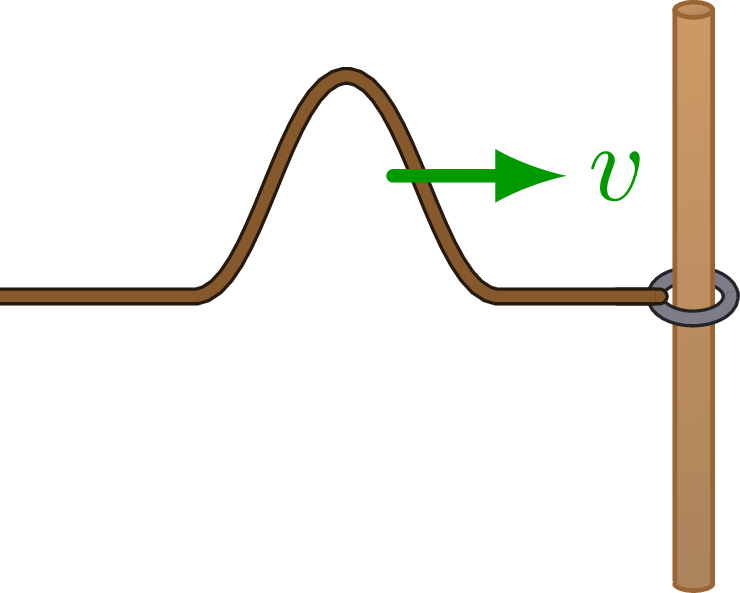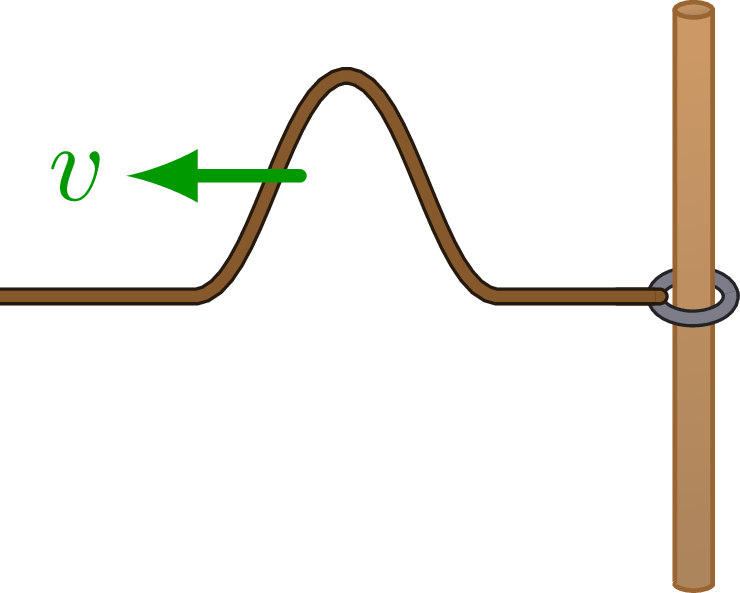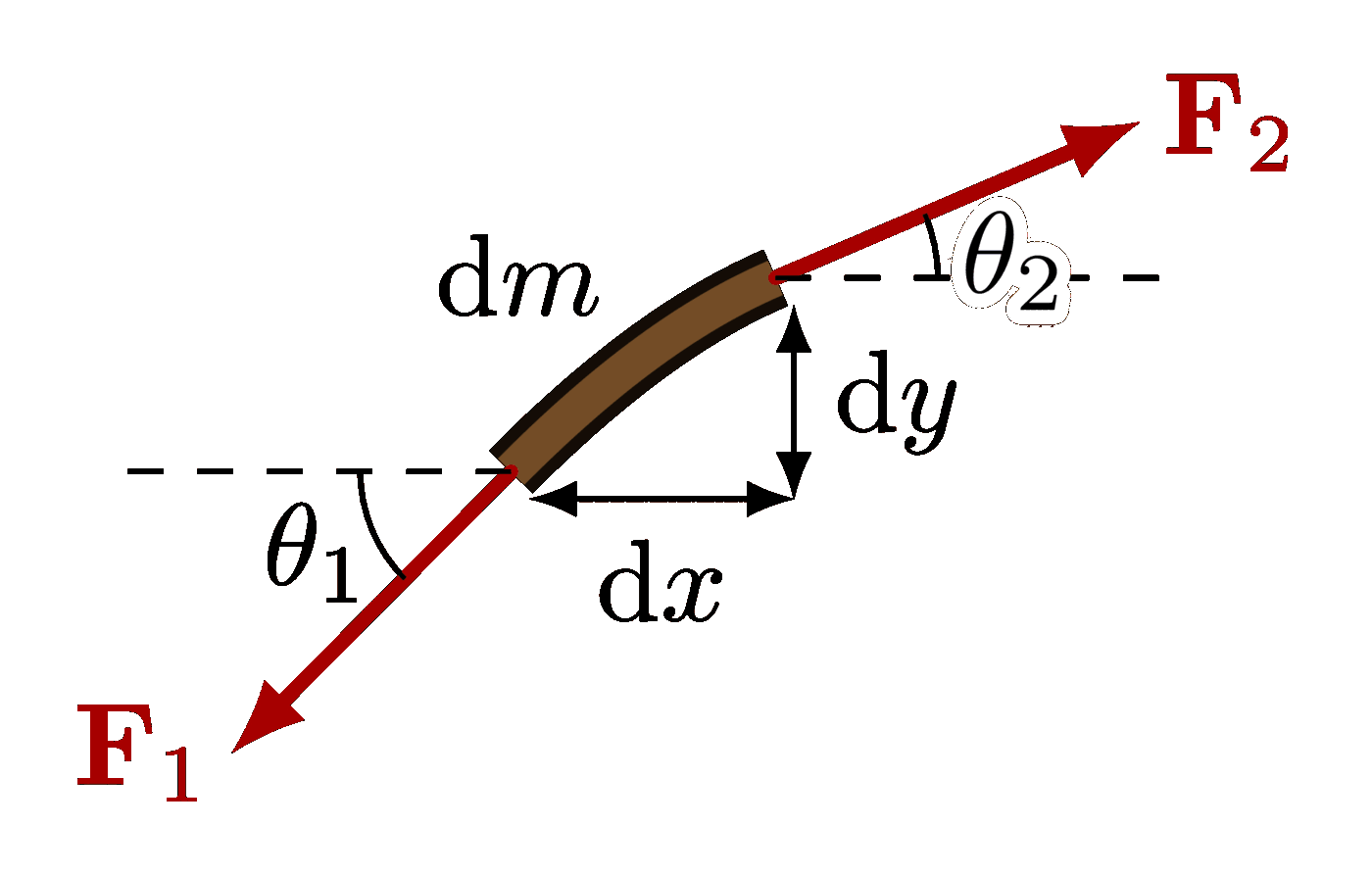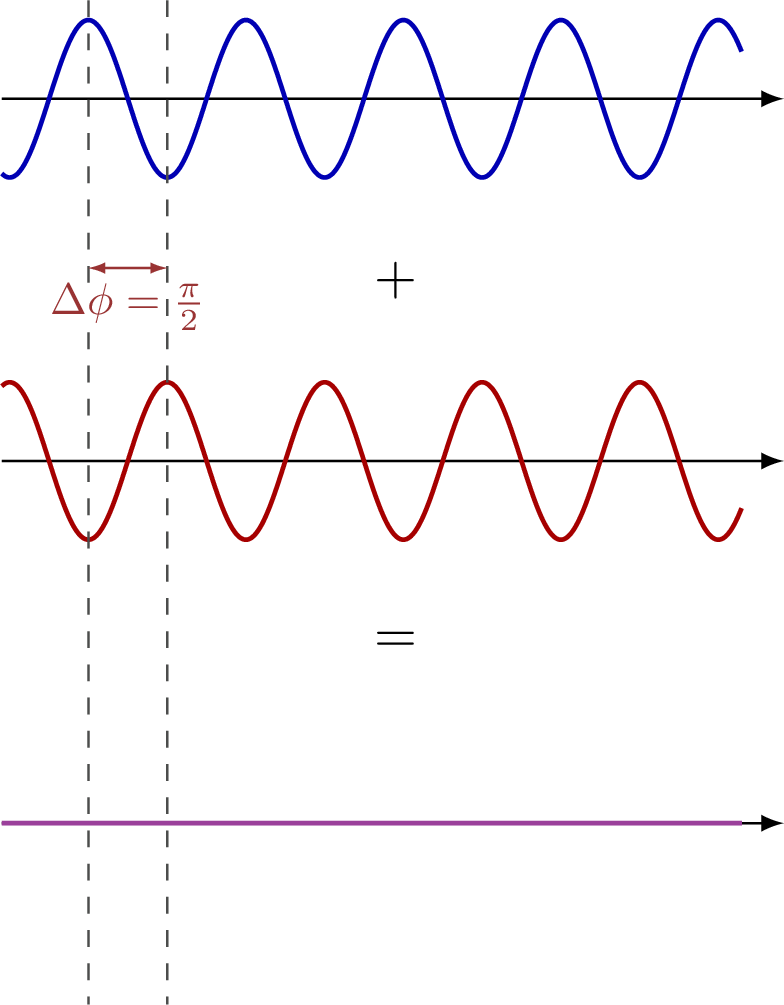Edit and compile if you like:
% Author: Izaak Neutelings (December 2020)
\documentclass[border=3pt,tikz]{standalone}
\usepackage{physics}
\usepackage{tikz}
\usetikzlibrary{calc} % for pic
\usetikzlibrary{angles,quotes} % for pic
\tikzset{>=latex} % for LaTeX arrow head
\colorlet{xcol}{blue!70!black}
\colorlet{vcol}{green!60!black}
\colorlet{metalcol}{blue!25!black!30!white}
\tikzstyle{vvec}=[->,vcol,very thick,line cap=round]
\tikzstyle{rope}=[brown!20!black,double=brown!70!black,double distance=1,line width=0.3] %very thick
\tikzstyle{thick rope}=[rope,double distance=2,line width=0.6]
\tikzstyle{metal}=[draw=metalcol!10!black,rounded corners=0.1,
top color=metalcol,bottom color=metalcol!80!black,shading angle=10]
\tikzstyle{ring}=[metalcol!20!black,double=metalcol!70!black,double distance=1,line width=0.3]
\tikzstyle{wood}=[draw=brown!80!black,rounded corners=0.1,
top color=brown!80,bottom color=brown!80!black!80,shading angle=10]
\def\wave#1#2{
({(#1-0.22)*\xmax},0) to[out=0,in=180,looseness=0.6] (#1*\xmax,#2*\ymax)
to[out=0,in=180,looseness=0.6]++ (0.22*\xmax,#2*-\ymax)
}
\def\pole#1{
%\draw[wood] (0,-1.3*\ymax) rectangle (\t,1.3*\ymax);
\draw[wood] (#1,-1.3*\ymax) |- (#1+\t,1.3*\ymax) -- (#1+\t,-1.3*\ymax) arc(0:-180:{\t/2} and {0.4*\t/2}) -- cycle;
\draw[wood] (#1+\t/2,1.3*\ymax) ellipse ({\t/2} and {0.4*\t/2});
}
\begin{document}
%\LARGE
% INCIDENT - FIXED
\def\xmax{2.2}
\def\ymax{0.7}
\def\t{0.12}
\def\x{-0.5}
\def\v{0.25*\xmax}
\begin{tikzpicture}
\coordinate (T) at (\x*\xmax,\ymax);
\draw[rope] (-\xmax,0) -- \wave{\x}{1} -- (0,0);
\draw[metal] (0,0) circle(0.7*\t);
% \draw[wood] (0,-1.3*\ymax) rectangle (\t,1.3*\ymax);
\pole{0}
\draw[vvec] (T)++(-65:0.5*\ymax) --++ (\v,0) node[right=-2,scale=1] {$v$};
\end{tikzpicture}
% REFLECTION - FIXED
\begin{tikzpicture}
\coordinate (T) at (\x*\xmax,-\ymax);
\draw[rope]
(-\xmax,0) -- \wave{\x}{-1} -- (0,0);
\draw[metal] (0,0) circle(.07);
%\draw[wood] (0,-1.3*\ymax) rectangle (\t,1.3*\ymax);
\pole{0}
\draw[vvec] (T)++(115:0.5*\ymax) --++ (-\v,0) node[left=-2,scale=1] {$v$};
\end{tikzpicture}
% INCIDENT - LOOSE
\def\Rx{0.12}
\def\Ry{0.07}
\begin{tikzpicture}
\coordinate (T) at (\x*\xmax,\ymax);
\draw[ring] (\Rx,0) arc(0:180:{\Rx} and \Ry);
%\draw[wood] (-0.48*\t,-1.3*\ymax) rectangle (0.52*\t,1.3*\ymax);
\pole{-0.48*\t}
\draw[ring] (170:{\Rx} and \Ry) arc(170:370:{\Rx} and \Ry);
\draw[rope,line cap=round] (-2*\Rx,0) -- (-0.88*\Rx,0);
\draw[rope] (-\xmax,0) -- \wave{\x}{1} -- (-\Rx,0);
\draw[vvec] (T)++(-65:0.5*\ymax) --++ (\v,0) node[right=-2,scale=1] {$v$};
\end{tikzpicture}
% REFLECTION - LOOSE
\def\Rx{0.12}
\def\Ry{0.07}
\begin{tikzpicture}
\coordinate (T) at (\x*\xmax,\ymax);
\draw[ring] (\Rx,0) arc(0:180:{\Rx} and \Ry);
%\draw[wood] (-0.48*\t,-1.3*\ymax) rectangle (0.52*\t,1.3*\ymax);
\pole{-0.48*\t}
\draw[ring] (170:{\Rx} and \Ry) arc(170:370:{\Rx} and \Ry);
\draw[rope,line cap=round] (-2*\Rx,0) -- (-0.88*\Rx,0);
\draw[rope] (-\xmax,0) -- \wave{\x}{1} -- (-\Rx,0);
\draw[vvec] (T)++(-115:0.5*\ymax) --++ (-\v,0) node[left=-2,scale=1] {$v$};
\end{tikzpicture}
% INCIDENT - THIN -> THICK
\begin{tikzpicture}
\coordinate (T) at (\x*\xmax,\ymax);
\draw[blue!20!black,line width=1.5]
(-\xmax,0) -- \wave{\x}{1} -- (0,0);
\draw[thick rope,line cap=round] (-0.01,0) -- (0.01,0);
\draw[thick rope]
(0,0) -- (\xmax,0);
\draw[vvec] (T)++(-65:0.5*\ymax) --++ (\v,0) node[right=-2] {$v$};
%\node[right] at (-1.5*\xmax,0.7*\ymax) {$t=0$};
\end{tikzpicture}
% TRANSMISSION - THIN -> THICK
\begin{tikzpicture}
\coordinate (L) at (\x*\xmax,-0.75*\ymax);
\coordinate (R) at (-\x*\xmax,0.25*\ymax);
\draw[blue!20!black,line width=1.5]
(-\xmax,0) -- \wave{\x}{-0.75} -- (0,0);
\draw[thick rope,line cap=round] (-0.01,0) -- (0.01,0);
\draw[thick rope]
(0,0) -- ({(-\x-0.16)*\xmax},0) to[out=0,in=180,looseness=1]
(-\x*\xmax,0.25*\ymax) to[out=0,in=180,looseness=1]++
(0.16*\xmax,-0.25*\ymax) -- (\xmax,0);
\draw[vvec] (L)++(115:0.4*\ymax) --++ (-\v,0) node[left=-2] {$v$};
\draw[vvec] (R)++(-10:0.1*\ymax) --++ (\v,0) node[above=4,right=-2] {$v'$};
%\node[right] at (-1.5*\xmax,0.7*\ymax) {$t=\Delta t$};
\end{tikzpicture}
% INCIDENT - THICK -> THIN
\begin{tikzpicture}
\coordinate (T) at (\x*\xmax,\ymax);
\draw[blue!20!black,line width=1.5]
(0,0) -- (\xmax,0);
\draw[thick rope,line cap=round] (-0.01,0) -- (0.01,0);
\draw[thick rope]
(-\xmax,0) -- \wave{\x}{1} -- (0,0);
\draw[vvec] (T)++(-65:0.5*\ymax) --++ (\v,0) node[right=-2] {$v$};
%\node[right] at (-1.5*\xmax,0.7*\ymax) {$t=2\Delta t$};
\end{tikzpicture}
% TRANSMISSION - THICK -> THIN
\begin{tikzpicture}
\coordinate (L) at (\x*\xmax,0.25*\ymax);
\coordinate (R) at (-\x*\xmax,0.75*\ymax);
\draw[blue!20!black,line width=1.5]
(0,0) -- \wave{-\x}{0.75} -- (\xmax,0);
\draw[thick rope,line cap=round] (-0.01,0) -- (0.01,0);
\draw[thick rope]
(-\xmax,0) -- ({(\x-0.16)*\xmax},0) to[out=0,in=180,looseness=1]
(\x*\xmax,0.25*\ymax) to[out=0,in=180,looseness=1]++
(0.16*\xmax,-0.25*\ymax) -- (0,0);
\draw[vvec] (L)++(190:0.1*\ymax) --++ (-\v,0) node[above=2,left=-2] {$v$};
\draw[vvec] (R)++(-65:0.4*\ymax) --++ (\v,0) node[above=2,right=-2] {$v'$};
%\node[right] at (-1.5*\xmax,0.7*\ymax) {$t=2\Delta t$};
\end{tikzpicture}
\end{document}Click to download: waves_reflection_transmission.tex • waves_reflection_transmission.pdf
Open in Overleaf: waves_reflection_transmission.tex


